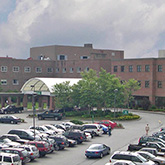At Central Vermont Medical Center our surgeons perform both mammogram-guided and ultrasound-guided Breast Needle Localization procedures.
Breast Needle Localization is a procedure used to identify the precise location of abnormal breast tissue for the purpose of removing it in the operating room. A special wire (Kopan Hook) or a dye (Methylene Blue) is used to “mark” the spot for the surgeon, using mammography or ultrasound. The type of localization is decided by you and your surgeon.
The procedure will be performed by your surgeon or a radiologist. A specially trained ultrasound or mammography technologist will assist.
Mammography-Guided Procedure
Breast Needle Localization is done in Mammography and is performed using either of the following procedures:
- Kopan Hook - A wire called a Kopan Hook, a needle that is inserted into the breast and held in place by a small hook at the end. This is performed the day of surgery.
- Methylene Blue - A dye is injected to “mark” the spot for the surgeon. This can be performed either the day of or the day before surgery.
Prior to the procedure, you will be asked to put on a gown. You will then be taken to the mammography area where the technologist will explain the procedure.
- You will be placed in a chair and your breast will be in compression.
- X-rays will be taken from different views to determine the location of the abnormality.
- The skin will be marked with a pen and then cleaned with a sterile solution. This area of the breast will be numbed with a small needle. You will feel an initial sting and then only pressure.
- A hollow needle will be placed within the breast at the area of concern. An x-ray is again taken to ascertain the initial positioning. If this is correct, a second image is taken to ensure the exactness of the positioning.
- Once verified, either a small wire is passed through the hollow needle or a blue dye is injected to the area of concern. The needle is removed and the wire remains in the breast until your surgeon removes it during surgery. The dye passes through the urine, which may be discolored, within 24-hours.
Ultrasound-Guided Procedure
An ultrasound-guided breast needle localization uses dye (Methylene Blue) to identify the breast tissue to be removed by the surgeon.
This procedure is often performed at the bedside in Ambulatory Care Unit (ACU) by your surgeon just before surgery:
- Prior to the procedure, you will be asked to put on a gown.
- You will lie on your back on a stretcher.
- The technologist will use ultrasound to locate the area of concern.
- The area is marked with a pen and then cleaned with a sterile solution. The skin of the breast will be “numbed” with a small needle. You will feel an initial sting and then only pressure.
- As the technologist uses ultrasound as a guide, the surgeon will place a hollow needle within the breast at the area of concern. A small amount of dye, called Methylene Blue, is injected through the needle and the needle is then removed.
After the Procedure
Once the breast needle localization procedure is complete, you will be taken in for your breast surgery. To learn more about this surgery, click here.
 General Surgeon
General Surgeon General Surgeon
General Surgeon General Surgeon
General Surgeon

CVMC General Surgery
Phone
Fax
802-225-7104

